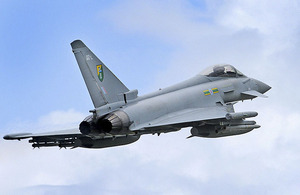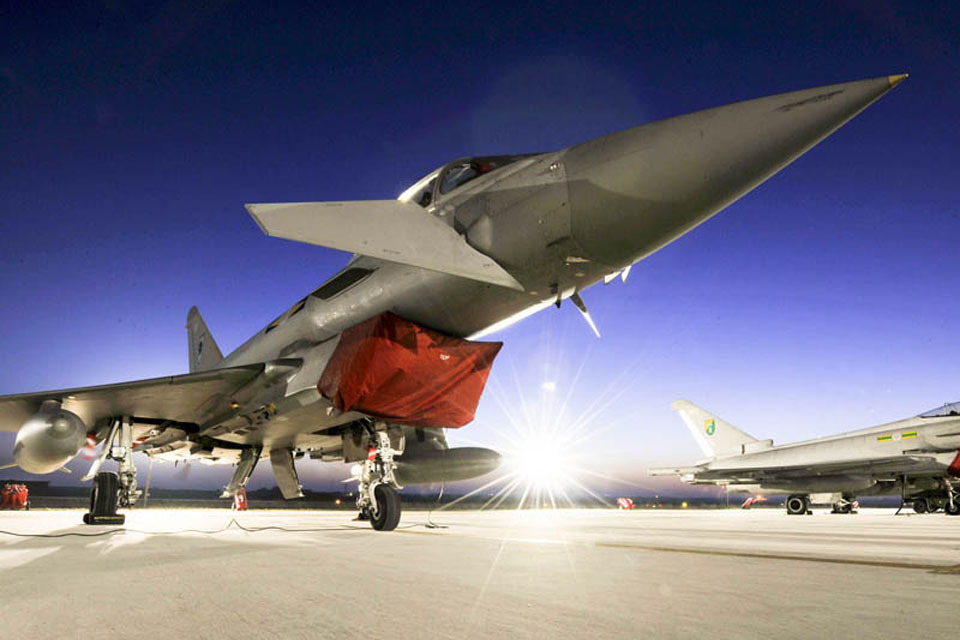Typhoon joins Tornado in Libya ground attack operations
Typhoon jets are providing a ground attack capability in addition to Tornado GR4 aircraft as British forces continue to support NATO operations in Libya.

RAF Typhoon FGR4 aircraft departs Gioia del Colle air base in southern Italy on a mission over Libya (stock image) [Picture: Corporal Babs Robinson RAF, Crown Copyright/MOD 2011]
Speaking to the media in London, Air Vice-Marshal Phil Osborn, Air Officer Commanding No 2 Group, said that the use of Typhoon in a multi-role fit, combined with Tornado, provides a highly responsive and balanced capability while maintaining the deployed force at the most efficient level.
The Typhoons are carrying Enhanced Paveway II bombs for the operation, complementing the ordnance carried by the GR4s and increasing the variety of precision-guided weapons available to NATO.
Air Vice-Marshal Osborn revealed that yesterday evening a Typhoon patrolling with a Tornado over western Libya was able to positively identify regime main battle tanks (MBTs) to the south of Misurata. The two aircraft attacked and the Typhoon successfully engaged two MBTs with Enhanced Paveway II bombs, while the Tornado hit another MBT with Paveway IV.
He also said that the RAF have sufficient Typhoon aircrew to undertake the current task, with appropriate training for all the systems and weapons carried by the aircraft, whether air-to-air or air-to-ground munitions.
Speaking about the wider operation, Major General John Lorimer, the Chief of the Defence Staff’s Strategic Communications Officer, said that most of the fighting in Libya remains focused firstly around the siege of Misurata by Colonel Gaddafi’s forces, and secondly the rather fluid situation in the region of Brega and Ajdabiya.
We should recognise that, within the constraints of air power, the NATO-led operation is delivering very real effect,” Major General Lorimer said.
Over the weekend, for example, NATO has reported successful engagements against 61 armoured vehicles and air defence assets. A third of these - 20 - were attacked by RAF fast jets, all in the area of either Misurata, or Brega and Ajdabiya.
As everyone recognises, Colonel Gaddafi still poses a very real threat to civilians, but other means, including infantry in pick-up trucks and technicals, which are of course much more challenging from a targeting perspective. But it is with heavy armour and artillery that the regime is most able to inflict extensive casualties on the civilian population, and day by day these assets are being steadily denied to the regime.
Since the start of operations to enforce UNSCR [United Nations Security Council Resolution] 1973, about 100 tanks, armoured vehicles, artillery and SAMs [surface-to-air missiles] have been engaged by RAF aircraft alone, including eight main battle tanks attacked yesterday.
Major General Lorimer said more needs to be done and NATO has asked for more ground attack aircraft to be made available, to which the UK has responded by increasing to twelve the number of Tornado GR4s deployed, and equipping four Typhoons to operate in either the ground attack or the air defence role as the commander requires.

RAF Typhoon aircraft await their next sortie at Gioia del Colle air base in southern Italy (stock image) [Picture: Senior Aircraftman Neil Chapman, Crown Copyright/MOD 2011]
He said that the use of Typhoon in a multi-role fit, combined with Tornado, provides a highly responsive and balanced capability while maintaining the deployed force at the most efficient level.
The General added that the RAF is now providing a quarter of the ground attack assets, and the UK is pressing other nations to match our commitment to what is proving to be the most important aspect of the NATO operation.
In addition, other RAF aircraft continue to provide invaluable support across the NATO effort: E-3D Sentries and VC10 and TriStar tankers provide a very significant proportion respectively of the AWACS (Airborne Warning and Control System) and air-to-air refuelling needed by the NATO operation, and the Sentinel and Nimrod R1 provide unique capabilities amongst the non-US forces.
These aircraft are all conducting very prolonged missions on a daily basis: RAF aircraft are flying on average around 15 per cent of the NATO sorties, but have been averaging about 25 per cent of the hours flown,” Major General Lorimer said.
At sea, he confirmed that HMS Liverpool took over patrolling responsibilities off the Libyan coast from HMS Cumberland last week and that the minehunter HMS Brocklesby has also been contributing to the maritime surveillance task. Meanwhile, the submarine HMS Turbulent remains on hand should targets specifically requiring a Tomahawk strike be identified.
Major General Lorimer stressed that the importance of the maritime patrol should not be underestimated:
The fact that thus far the enforcement of the arms embargo under UNSCRs 1970 and 1973 has not been challenged should not belie the necessity for it, particularly as over time the regime’s military resources are lost or expended.